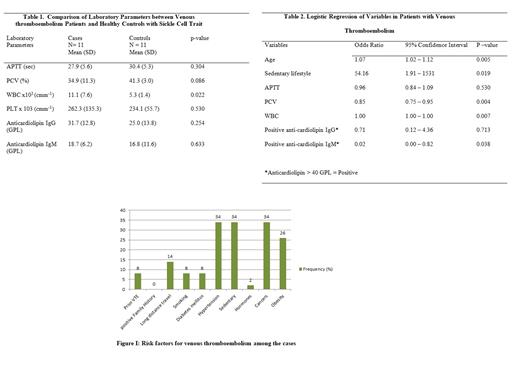Abstract
Introduction
Among the risk factors for venous thromboembolism (VTE) are inheritance of the sickle cell gene and antiphospholipid syndrome. Antiphospholipid antibodies are elevated in sickle cell disease but there is little information on its levels in sickle cell trait. The prevalence of anticardiolipin antibodies and association with VTE is equally not known in the Nigerian population.
Methods
A case control study involving 50 consecutive patients with Doppler confirmed venous thromboembolism at the University College Hospital Ibadan and 50 apparently healthy individuals. Haemoglobin electrophoresis was carried out using cellulose acetate membrane. IgG and IgM anticardiolipin antibodies were assayed by ELISA.
Results
The mean age of the patients was 58.7±18.5years, range of 21-89 years, there were 21 males (42%). Majority of the patients (42 (84%)) had deep venous thrombosis while five (10%) patients presented with pulmonary embolism, one had both deep venous thrombosis and pulmonary embolism. A patient had portal vein thrombosis and another, an intracardiac clot. Sedentary lifestyles, hypertension and concomitant malignancy were the most prevalent risk factors (34% each) (figure I). Both sedentary lifestyle and cancer were significantly associated with VTE (p<0.001). Sickle cell trait (Hb AS) occurred in the same number of patients and controls (eleven each). Higher levels of both IgG and IgM anticardiolipin antibodies were found among the VTE patients with sickle cell trait than controls. (Table 1) The mean levels of IgG antibody in Hb AS patients was 31.7 ± 12.8 GPL compared to 25 ± 13.8 GPL in the controls (p= 0.254) and mean IgM anticardiolipin antibodies in Hb AS patients was 18.7 ± 6.2 GPL while that of the controls was 16.8 ± 11.6 GPL (p= 0.633). The global mean levels of IgG and IgM anticardiolipin antibodies in the patients with VTE were 29.7 ± 9.1 GPL and 24.8 ±16.7 GPL respectively versus 28.5 ±13.7 GPL and 25.2 ±16.2 GPL in the controls. A multivariable logistic regression showed age, sedentary lifestyle and anemia as independent risk factors while a positive IgM anticardiolipin antibody appeared protective for VTE. (Table 2)
Conclusion
The prevalence of sickle cell trait and anticardiolipin levels did not differ between VTE patients and healthy controls. Age, hypertension, sedentary lifestyle and malignancies were identified risk factors in our cohort of patients. Larger prospective studies may be helpful in determining the influence of sickle cell trait and antiphospholipid antibodies in venous thromboembolism.
No relevant conflicts of interest to declare.


This feature is available to Subscribers Only
Sign In or Create an Account Close Modal